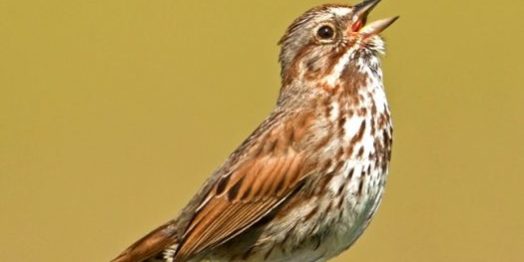Bird of The Week: Song Sparrow
SCIENTIFIC NAME: Melospiza melodia
POPULATION: 130 million
TREND: Decreasing
HABITAT: Breeds and winters in brushy, weedy edges, often along streams or in marshes. Common in suburban habitats
At first glance, the Song Sparrow is a typical “little brown job,” a term sometimes bestowed by frustrated birders on species in the large, often look-alike sparrow family. But a closer look at this familiar bird reveals a species as variable and interesting as the most exotic quetzal or cotinga. The Song Sparrow lives up to its name, singing persistently throughout the year. Its song consists of three to four short notes followed by a varied trill, sometimes represented as “maids, maids, maids, put on your teakettle-ettle-ettle ettle.” Its call is a loud, distinctive “chimp.”
Vociferous, Variable Singer
Most males sing six to 24 variations of this tune, sometimes as often as five to ten times per minute when establishing territories in the spring. Research shows that females, which sing much less frequently, are attracted to the variability and uniqueness of an individual male’s song.
Young male Song Sparrows develop unique song patterns, which they learn by listening to and copying the songs of adult males nearby. Songs become more complex as the young bird matures, then attempts to establish a breeding territory the following spring. Ultimately, each male develops his own musical repertoire.
Bird of Many Variants
Like the Horned Lark, the Song Sparrow is one of the bird world’s most “polytypic” — having more than one type — with 24 to 38 subspecies recognized across Canada, the United States, and Mexico. The nominate subspecies of Song Sparrow, found across the eastern U.S., is a medium-sized, streaky-breasted, rather chunky brown bird. However, the Song Sparrow subspecies found in the Aleutian Islands is darker-colored and larger, too — about the about the size of a towhee. Another subspecies inhabits the riparian woodlands of the arid southwest, where ABC is working, to conserve habitat for Southwestern Willow Flycatcher and western populations of Yellow-billed Cuckoo.
Most Song Sparrow populations are migratory and face the typical gamut of human-caused threats as they travel, including collisions, particularly with glass; outdoor cats; and pesticides. Some western U.S. and island subspecies are threatened by habitat loss. Song Sparrows are one of the most frequently noted hosts of Brown-headed Cowbird.
Like Grasshopper and Vesper Sparrows, Song Sparrows switch their diet with the seasons, feeding on insects during spring and summer and seeds in fall and winter. The birds forage on the ground in a wide variety of habitats and visit backyard feeders for seed during the winter, often alongside Sparrows. Unlike many of its more elusive relatives, the Song Sparrow is common in suburban and even urban areas. In brightly lit urban areas, some Song Sparrows will sing through the night, apparently thinking the sun is just about to rise!
SOURCE: abcbirds.org (American Bird Conservancy)


